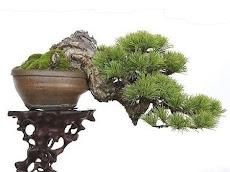
photo by:gardening.savvy-cafe.com
Story by:Christine McKinnon
The art of bonsai trees care is widely attributed to have developed in China more than a thousand years ago. Its true roots lie in antiquity as Archaeologists have found evidence of trees grown in containers in ancient Egypt, the Middle East and Mediterranean.
One of the bonsai legends from China concerns an emperor who used bonsais to create a miniature model of his entire kingdom, complete with rivers, lakes, hills and trees, so he could view the world he ruled over from his palace window. He would, of course, have had servants did all the bonsai trees care for him - and woe betide them if they should die.
The Japanese have, in the centuries since, refined the growing and care for bonsai trees and it's now become a hobby practiced widely throughout the world. The word bonsai is itself Japanese. It is in fact two words - bon, meaning tray and sai meaning growing.
Many bonsai growers use wire to help twist their tree's trunk into gnarled and windswept shapes, sometimes giving them the appearance of dragons or birds. The shape speaks of tranquility, endurance and a timelessness that evokes an emotional response.
The tree, despite being miniaturized, behaves like its full grown relatives and experiences the rhythm of the season, losing its leaves in winter and, if it's a flowering shrub, producing buds in spring. As the creator, and those tasked with the bonsai trees care, this gives a rewarding sense of creativity and hopefully inner peace.
When creating a bonsai, almost any woody stemmed tree or shrub can be used. Firstly you must decide whether you want your bonsai tree inside or outside. Inside trees do not thrive outside and generally the same goes for outside trees placed indoors. Two trees often recommended for beginners are the Japanese red maple and the juniper. You can of course choose to start with seeds, but they do take a little more time and effort.
In order to make the right choice, you must decide what style you are looking for. They range from a full cascading shape, to windswept and upright and a number of in-between variations . One of the easiest for beginners is what's known as the "formal upright". This type of bonsai has a straight trunk with the widest branches at the bottom. The branches get smaller as they proceed up the trunk so that you end up with a shape rather like a triangle. Trees easy to cultivate in this manner include the juniper, spruce, larch and pine - all of which are again relatively easy and popular varieties for a beginner.
One of the most popular styles is the windswept look, where a gnarled, ancient looking tree appears to have survived centuries of wintry blasts. Many of these specimens can live for centuries with proper bonsai trees care, others are nowhere near as old as they look. Bonsai masters have, over the years, perfected the art of creating that tortured, aged appearance.
A very important thing consider, when selecting your tree, is to ensure that it has a good root spread and balance. You should also look carefully at the leaves. Small leaves, close together, help create a plentiful illusion when in fact the branch is so small, there is limited space for abundance.
Look at the trunk. Does it have an interesting shape? Is there a curve or sweep that can be encouraged through binding? What sort of texture does the bark have? Selecting a tree with the right qualities in the first instance can help quicken and enhance your end result and this will help to make you successful with bonsai trees care.
Choose the pot to complement your tree and get some expert advice on how to prune the top of your tree. Consider carefully which branches to remove and which to keep in order to create the desired effect. Never remove more than a third of the foliage in one go. It generally takes three to five years of growth and bonsai trees care to obtain the shape you are seeking.
There will come a time when you bonsai will need its roots trimmed and to be repotted. That's generally done anywhere between one and five years after purchase of your tree and something you can take time to learn. As you don't want to end up killing your tree, it's vitally important though to get the proper know how first.
Another vital aspect for bonsai trees care is watering. You should check the soil at least once every two weeks. Not enough water and your tree could be very quickly fighting drought conditions. Too much water and it will be at risk from fungal infections and root rot.
Just like any other plant, bonsais need light - but some more than others. Leafy trees for instance prefer semi-shade and tough-needled pines like full sun. Feeding will also help keep your bonsai healthy, especially as their small pots can easily get drained of nutrients. There are a variety of different fertilizers you can use and again it is best to seek out specialist knowledge to find the right type to suit your particular tree.
While all this may seem like a lot to take in, bonsai trees care is really simply a matter of following a few basic, time tested rules and you can become successful with the cultivation of beautiful bonsai trees.
About Author Christine McKinnon :
If you'd like to learn more about the easy tips of Bonsai trees care mentioned in this article, you can do so here http://www.bonsai-trees-care.com
Article Source: http://www.BharatBhasha.com
Article Url: http://www.bharatbhasha.com/family.php/160961



